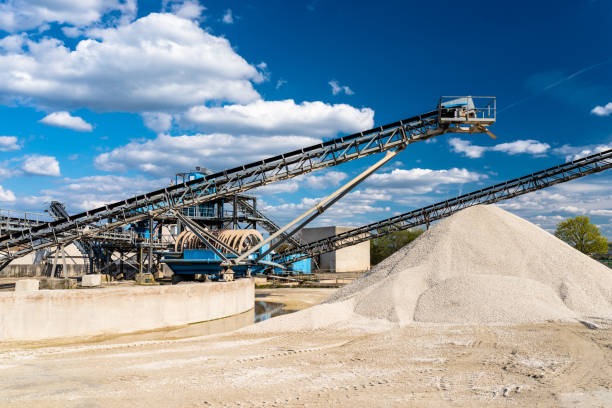Crushing operations play a pivotal role in industries like mining, construction, and aggregate production. These operations involve the reduction of large rocks, minerals, and other materials into smaller, more manageable sizes. The crusher feeder system, particularly the hopper feeder, is key to the efficiency and safety of crushing operations. This article will explore the significance of hopper feeders in crushing operations and how prioritizing safety in their design and maintenance is essential for a successful and secure crushing process.
Understanding the Role of a Crusher Feeder
A crusher feeder is an integral crushing plant component, acting as a crucial intermediary between the primary crusher and the raw materials it processes. The primary function of a crusher feeder is to regulate the flow of material into the crusher, ensuring a consistent and controlled supply. This regulation is essential to prevent overloading the crusher, which can lead to damage, reduced efficiency, and safety hazards.
The Basics of a Hopper Machine
Before delving deeper into the importance of hopper feeders, it’s essential to understand what a hopper machine is. A hopper is a container with an open top, often funnel-shaped, designed to hold and dispense materials. Hoppers are commonly used in various industries for storing and transporting bulk materials, such as ores, aggregates, and grains.
In the context of crushing operations, a hopper machine is a specialized type of hopper that is integrated into the crushing system. It serves as the initial point where raw materials are deposited before being fed into the crusher. Hopper machines are equipped with mechanisms, such as feeders, to control the discharge of materials into the crusher, ensuring a steady and uniform flow.
Types of Hopper Feeders
In crushing operations, various types of hopper feeders are employed to efficiently and safely regulate the flow of raw materials into the crusher. Each type of hopper feeder offers distinct advantages suited to specific operational requirements:
- Vibrating Feeders: Vibrating hopper feeders use vibrations to convey materials. They are highly versatile and can handle various materials, including large, sticky, or abrasive particles. The vibrations help prevent material blockages and ensure a consistent flow into the crusher.
- Apron Feeders: Apron feeders consist of a series of overlapping metal plates or pans connected to heavy-duty chains. They are ideal for handling heavy, bulky materials and are known for their robustness and durability. Apron feeders excel in applications with severe impact and high loads.
- Belt Feeders: Belt feeders utilize conveyor belts to transport materials. They are suitable for applications where precise material control is essential. Belt feeders offer adjustable speed and capacity, making them ideal for a wide range of material types and sizes.
- Screw Feeders: Screw hopper feeders use rotating screws to move materials along a trough. They are effective for handling fine or powdery materials with consistent flow requirements. Screw feeders are known for their accuracy and reliability.
- Grizzly Feeders: Grizzly hopper feeders incorporate a series of bars or grids to screen out oversized materials before they enter the crusher. This type of feeder is particularly useful in preventing large, undesirable objects from causing damage to the crusher.
Choosing the right type of hopper feeder depends on factors, including the material characteristics, throughput requirements, and the specific demands of the crushing operation. Each type offers unique benefits, contributing to the overall efficiency and safety of the crushing process.
The Significance of Hopper Feeders in Crushing Operations
Hopper feeders are central to the efficiency and safety of crushing operations for several reasons:
1. Controlled Material Flow
One of the primary functions of hopper feeders is to regulate the material flow into the crusher. This control ensures the crusher receives a consistent feed rate, preventing overloading and optimizing its performance. Without proper control, uneven material flow can lead to inefficient crushing, increased wear and tear on equipment, and even unexpected downtime.
2. Safety and Accident Prevention
Safety is paramount in any industrial operation, and crushing operations are no exception. A well-designed hopper feeder system can significantly reduce the risk of accidents and injuries. By maintaining a steady and controlled material flow, hopper feeders help prevent material spillage, blockages, and the associated safety hazards that can arise from these issues.
3. Improved Crusher Efficiency
Efficiency is a key concern in crushing operations, directly impacting production output and operating costs. A properly functioning hopper feeder contributes to overall efficiency by ensuring that the crusher operates at its optimal capacity. When the crusher receives a consistent and appropriate feed rate, it can perform more efficiently, leading to higher productivity and reduced energy consumption.
Prioritizing Safety in Crushing Operations
To ensure hopper feeder security and overall safety in crushing operations, the following measures should be prioritized:
1. Regular Maintenance and Inspection
Routine maintenance and inspection of hopper feeders are crucial. This includes checking for wear and tear, loose components, and proper alignment. Any issues should be addressed promptly to prevent potential failures that could compromise safety.
2. Training and Education
Operators and maintenance personnel should receive proper training and education on the safe operation and maintenance of hopper feeders and crushing equipment. Knowledgeable and skilled personnel are essential for preventing accidents and ensuring the equipment functions as intended.
3. Use of Safety Devices
Safety devices like sensors and alarms can be integrated into hopper feeder systems to alert operators to potential issues, such as material blockages or overloading. These devices can provide early warnings, allowing operators to take corrective actions before safety hazards escalate.
4. Adequate Clearing and Cleanup Procedures
Establishing clear procedures for clearing material blockages and conducting cleanup operations is essential. These procedures should be followed diligently to prevent accidents and maintain the integrity of the hopper feeder system.
5. Emergency Response Planning
In the event of a safety incident, having a well-defined emergency response plan is crucial. This plan should outline procedures for addressing accidents, ensuring personnel safety, and minimizing equipment damage.
Conclusion
Hopper feeders are indispensable components in crushing operations, playing a vital role in controlling material flow, enhancing safety, and improving overall efficiency. Prioritizing safety in crushing operations, particularly in the design, maintenance, and operation of hopper feeders, is essential to prevent accidents, protect personnel, and ensure the longevity of equipment.
Crushing operations can be demanding, but with proper attention to safety measures and the utilization of well-designed hopper feeder systems, they can be carried out efficiently and securely, contributing to the success of various industries that rely on material reduction processes.

